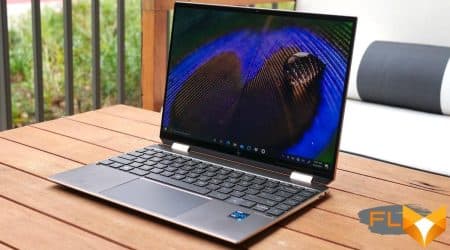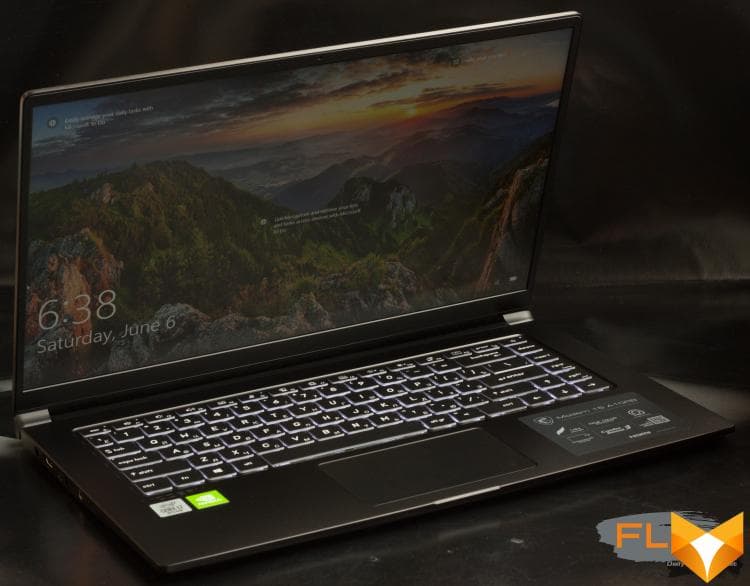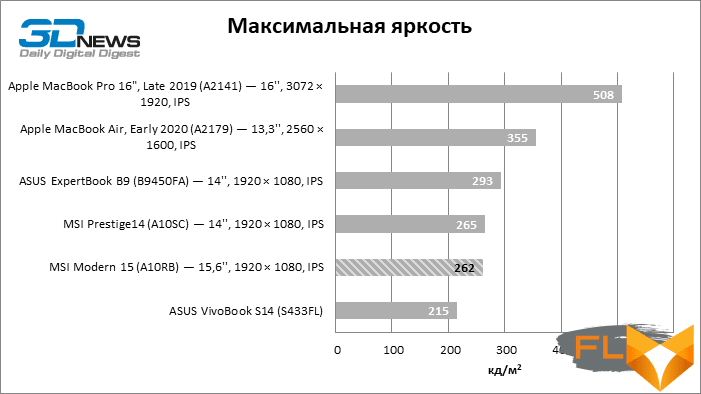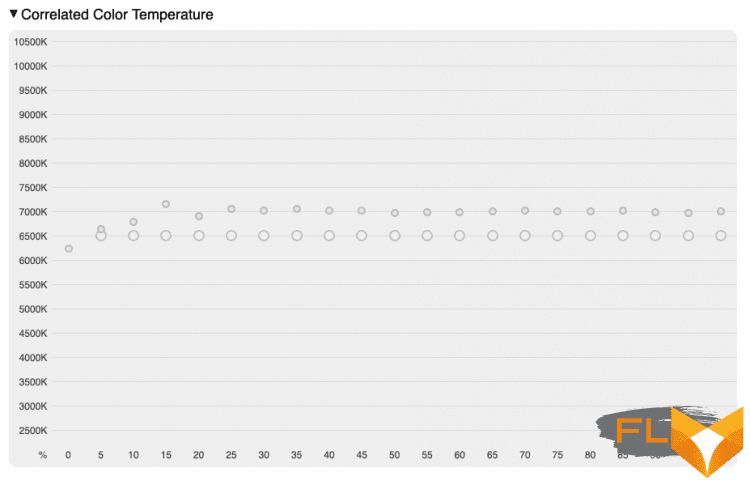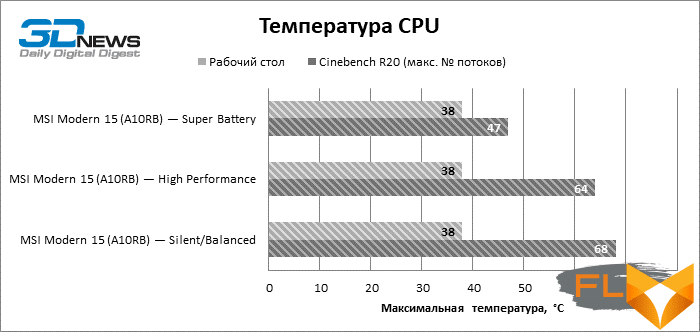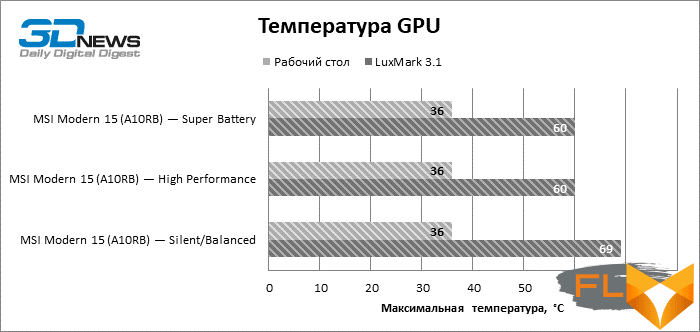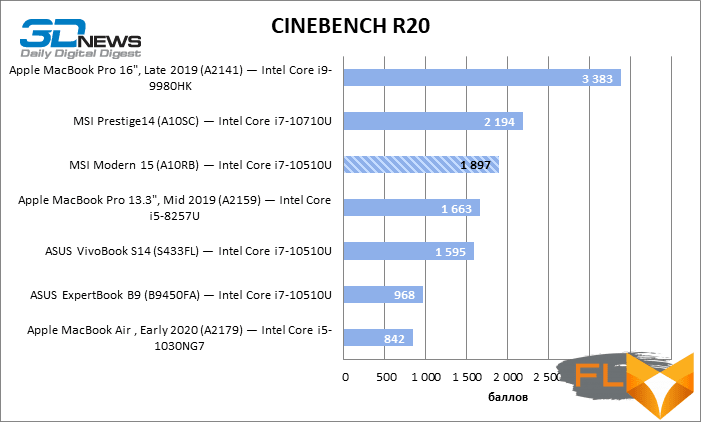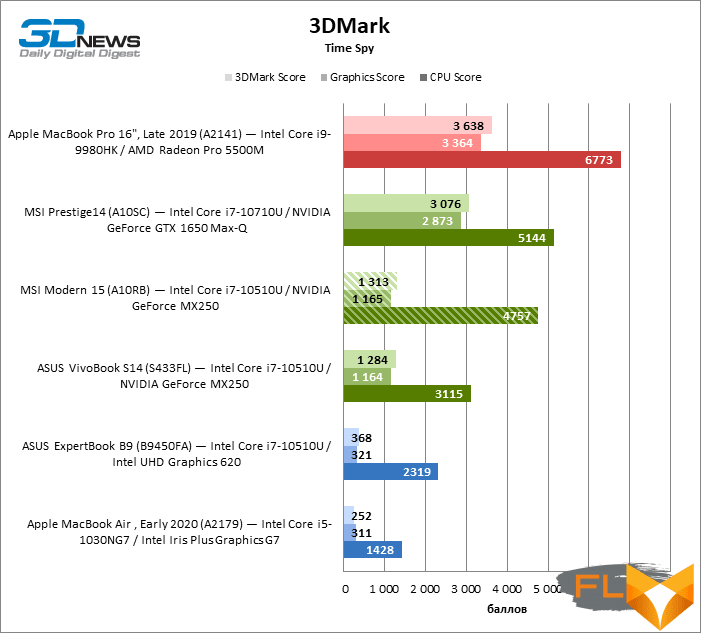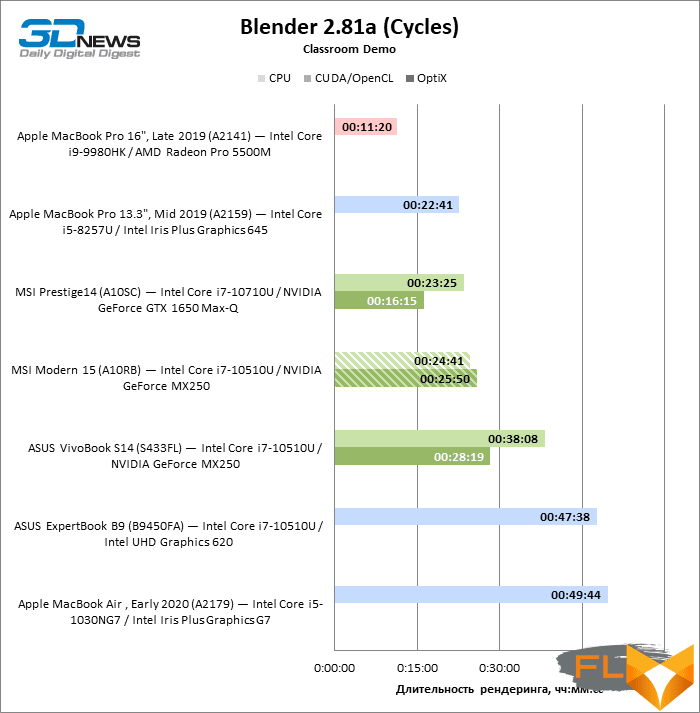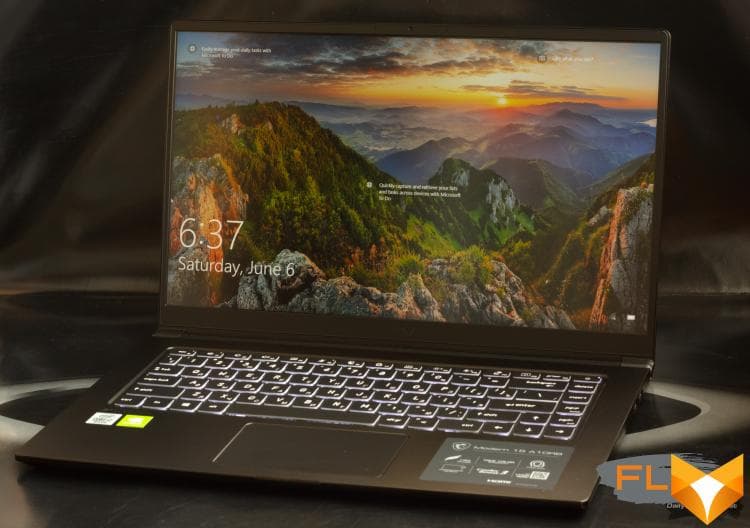


Most of the laptops that pass through us are either powerful gaming models or thin ultrabooks, but almost every one of them claims to be great things – in performance, weight reduction, battery life, or both. However, a practical buyer is more likely to be interested in a computer, the characteristics of which are dictated by the price, and not by the desire for records. This is the hero of today’s review, a laptop with a screen of 15.6 inches MSI Modern 15. Dimensions, filling and design – all this makes the new product related to business-oriented models that fit better into an office interior than a coffee shop or an airliner cabin. But modesty in this case is not synonymous with mediocrity. MSI Modern 15 found something to surprise us even against the background of expensive analogues.
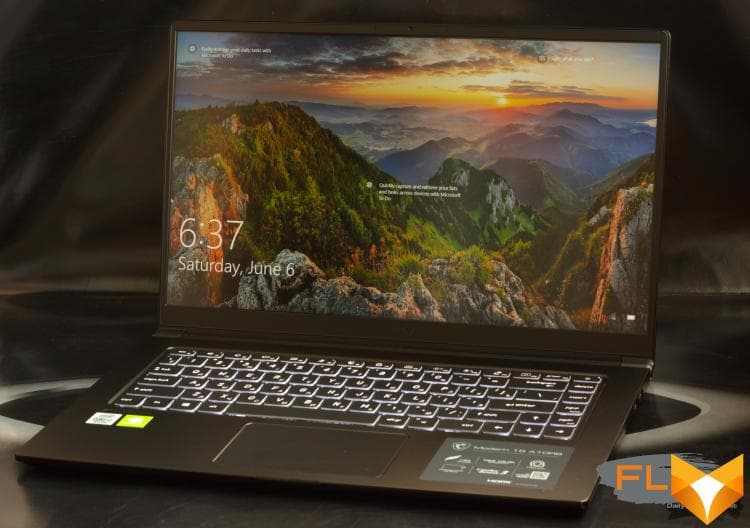
⇡#Tech Specs, PricingMSI is based on Intel’s 10th Generation U-series processors, which are most commonly found in ultra-thin models with screen sizes of 13.3-14 inches, instead of more powerful chips marked H. In addition, the two CPU varieties featured in the Modern 15 specifications (Core i5-10210U and Core i7-10510U) are quad-core processors, while six- and even eight-cores are no longer a rarity in the 15.6-inch form factor.
But do not rush to close the article, having read up to this point. As we will have time to see for ourselves, the spacious chassis made it possible to overclock the economical quad-core CPU so much that you can do without two “extra” cores in most tasks. This, in our opinion, is the key advantage of the Modern 15 (which, alas, is not reflected in the compressed specification table) in the context of its price and the characteristics of its closest competitors: the basic configuration of a machine with a Core i5-10210U at the time of writing the review could be bought for under $1,100, while Core i7-10510U-based variants start at around $1,500. After all, all offers similar in cost and dimensions are also entirely quad-core – either on Intel Comet Lake chips (like Modern 15), or even on low-wattage Ice Lake silicon.
| Manufacturer | MSI |
|---|---|
| Model | Modern 15 |
| Display | 15.6”, 1920 × 1080 (60Hz), IPS |
| CPU | Intel Core i5-10210U (4/8 cores/threads, 1.6-4.2 GHz); Intel Core i7-10510U (4/8 cores/threads, 1.8-4.9 GHz) |
| RAM | 2 × DDR4 SDRAM, 2666 MHz, 8-64 GB (two channels) |
| GPU | Intel UHD Graphics 620; NVIDIA GeForce MX250 (2 GB); NVIDIA GeForce MX330 (2GB) |
| Accumulator | 2 × M.2 in SATA3/PCI Express x4 3.0 mode |
| External I/O connectors | 1 × USB 3.2 Gen 1 Type-C / DisplayPort; 1 x USB 3.2 Gen 1 Type-A; 2 x USB 3.2 Gen 2 Type-A; 1 x HDMI; 1 x Micro SD; 1 x TRS 3.5mm |
| Network | IEEE 802.11ac + Bluetooth 5.0 |
| Battery capacity, Wh | 52 |
| Weight, kg | 1,6 |
| Overall dimensions (L × H × D), mm | 356.8 × 233.7 × 15.9 |
| Retail price | From $1,100 (Core i5-10210U, GeForce MX250 8GB, 512GB) |
The next advantage of the Modern 15 is a discrete GPU – GeForce MX250 or MX330 with 2 GB of dedicated memory. In terms of speed, they are almost indistinguishable from each other, but each model is divided into two varieties depending on the power reserve available to it. The MSI laptop that we will be testing (modification A10RB) received an older version of the MX250 with a TDP of 25W. Of course, a graphics adapter based on the budget GP108 chip is not a gaming-grade solution, but within $ 1,200 there are a lot of devices without discrete graphics at all, and in such work tasks as photo processing or video encoding, the GeForce MX250 is obviously stronger than the integrated video core.
The rest of the specifications are quite typical for a modern laptop: dual-channel DDR4 RAM ranging from 8 to 64 GB and an NVMe SSD. The only thing that could be focused on is the battery capacity. While other 15-inch laptops boast 99.9 Wh batteries (no more – they will not be allowed to be transported on an airplane), the Modern 15 is equipped with a battery with a capacity of 52 Wh. However, in conjunction with the U-series processor, it provides good autonomy in business use modes.
⇡#Look and Ergonomics
The design of the Modern 15 is reminiscent of MSI’s 14-inch Prestige series, which we reviewed in April, and if you put the larger Prestige 15 side by side, you can only tell one device from another by the size of the touchpad and the configuration of external connectors. This, of course, is a compliment for a relatively inexpensive laptop, which is the Modern 15.
The chassis of the novelty is assembled from aluminum panels and is either light gray or black – like the laptop that came to us for testing. Among not-so-compact 15.6-inch siblings, the Modern 15 stands out with thin bezels around the matrix and, accordingly, modest dimensions in width and depth, which, it seems, simply cannot be reduced without sacrificing a webcam or lowering the lower edge of the display. to the keyboard level. In addition to this, the laptop is quite thin (only 15.9 mm), and thanks to the beveled edges of the lower half of the case, it looks even lighter and thinner than it really is. But it is really light: most similar devices with discrete graphics weigh more than 1.6 kg.
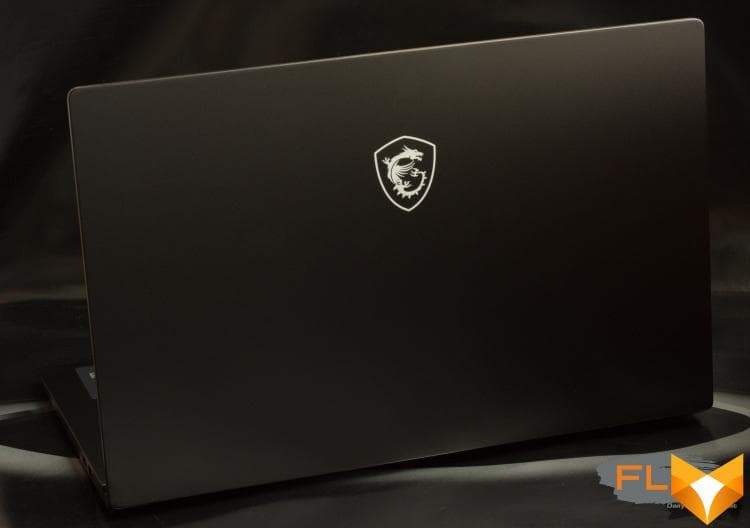
Alas, thin walls did not benefit the rigidity of the case. Not only MSI, but also other manufacturers have already forced us to come to terms with the fact that it is easy to push through the laptop cover in the middle or bend it with a “screw”, but the Modern 15 has another weak point – the panel around the keyboard and touchpad also resists pressure poorly, and this easy to feel in the process of printing. However, we must pay tribute to the designers of the machine: thanks to the nine legs that support the case, the keyboard is not as jumpy as laptops with a fashionable “arched” stand. In ultrabooks with a screen of 13.3 or 14 inches, it is now customary to raise the bottom of the chassis above the work surface (the laptop rests on the ledge of the screen block to facilitate the work of the cooling system), but the Modern 15 does not need this at all: two fans are enough for a grill that takes up a good part of the area of the bottom panel. In addition, the classic design in this case does not interfere with tilting the screen at least 180 ° from the base.
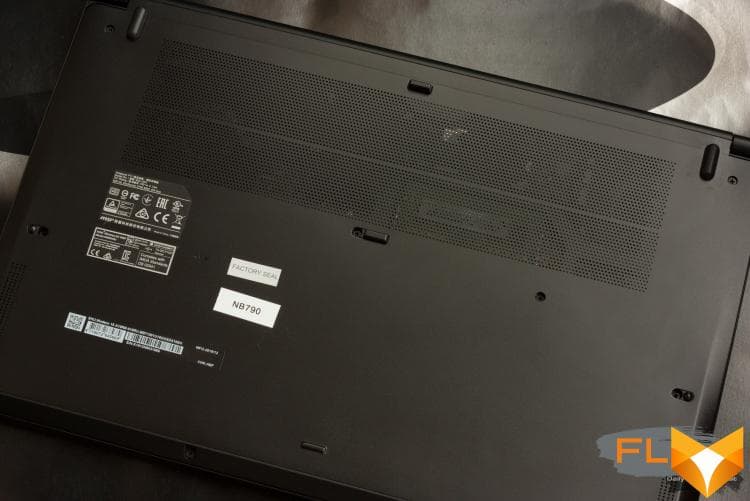
As for the controls themselves, the Modern 15 and the already familiar Prestige 14 have the same keyboard in all appearances. As a result, the novelty did not get the digital block, but whether it is useful in models with a screen less than 17 inches is a moot point, but everyone will appreciate the large keys. However, MSI should have sacrificed unification in order to use the free space under the screen more productively: the Delete, Insert, PgUp and PgDn keys, allocated to the right row, still squeeze the “~” key (and, accordingly, “ё”) on the other edge . And, unfortunately, on the large button covers and the generally successful layout, the advantages of the Modern 15 keyboard end. The key mechanism provides a deep travel of 1.5 mm, but the tactile feedback, especially important for fast touch typing, is very blurry on the cones underlying them.
The Modern 15 touchpad also leaves much to be desired, and it’s not at all about the area, which is much smaller than that of the Prestige series models, but again in the mechanics. The manipulator is well configured for cursor tracking and gesture recognition, but, firstly, it “clicks” loudly, and, secondly, the panel trembles and beats against something when lightly tapped with one or two fingers.
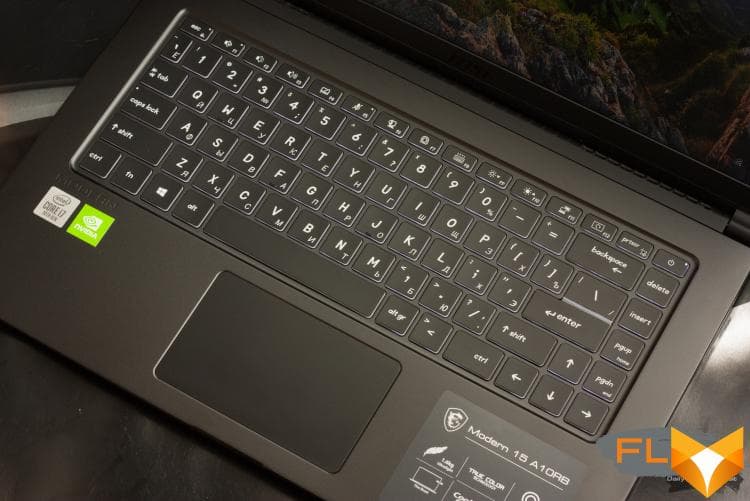
All wired communications of the laptop are dispersed along the side faces of the case. The Modern 15 has three USB Type-A ports and a single Type-C port combined with a DisplayPort video output. Fortunately, all USB connectors here work at 3.1 Gen 1 or Gen 2 speeds without such unpleasant surprises as USB 2.0 ports on the Prestige 14. But with Thunderbolt 3, as expected, the more democratic model had to part, but there is a full-sized HDMI and a spring-loaded microSD card reader slot.

Since the Modern 15 does not have Thunderbolt connectors, there is no possibility of charging through this interface, and the compact 90W power supply is connected with a standard barrel plug. By the way, the power supply is the only accessory that we found in the box with the device, but nowadays even more expensive laptops do not indulge the buyer with a generous package.
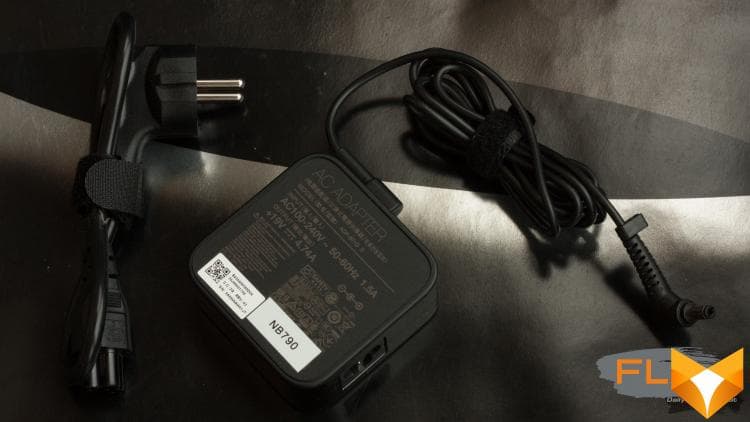
Above the screen is a webcam with quite typical characteristics suitable for video communication: 720p resolution and 30 FPS. The built-in speaker system is also better left for voice communication. While 15″ laptops sometimes find room for large drivers and reverb chambers, this is not the case with the Modern 15. The speakers are loud enough to fill a medium-sized room, but lack bass, as you’d expect.
⇡#Internal design and upgrade options
Unlike many ultra-compact 13.3″ or 14″ machines, the MSI Modern 15’s design makes it easy to upgrade components. RAM is recruited with SO-DIMM modules, and there are two M.2 slots for solid state drives at once.

The other thing that caught my eye after we removed the Modern 15’s bottom cover was the serious-looking cooling system. The cooler consists of two partly connected and partly independent circuits to remove heat from the CPU and GPU. One common thermal pipe is soldered to the CPU and GPU heat sinks, but each of them has its own heatsinks with separate tubes: the CPU has a smaller one, the GPU has a larger one. It is also noteworthy that, in addition to removing heat from the main and most energy-intensive chips, MSI took care of cooling their power harness, as well as the RAM of the video adapter.
But the fact that the Modern 15 has such a modest battery with a capacity of 52 Wh, as the autopsy showed, is not at all to blame for design limitations, but for the desire to reduce the cost: the space in which additional battery cells could be placed is simply not occupied.
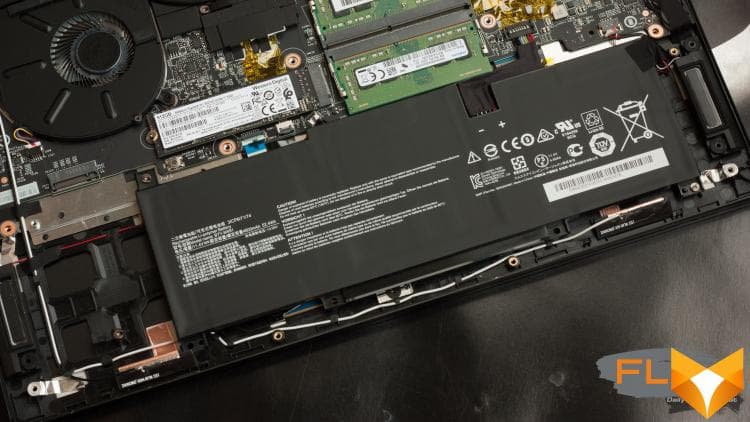
⇡#Test Methodology
| Synthetic tests | |
|---|---|
| Application | Settings |
| 3DMark Time Spy | — |
| Geekbench 4 | — |
| CINEBENCH R20 | — |
| GFXBench 5 (Aztec Ruins — Normal Tier, High Tier) | Windows: Vulkan, macOS: Metal |
| fio 3.16 | Sequential read/write, random read/write (unbuffered I/O) |
| Working Applications | |||||
|---|---|---|---|---|---|
| Application | Benchmark | Settings | API | ||
| Intel Graphics | AMD Graphics | NVIDIA Graphics | |||
| Adobe Photoshop CC 2019 | PugetBench for Photoshop CC 0.8 (linked test structure) | Basic Benchmark | OpenGL + OpenCL + Metal (macOS) | OpenGL + OpenCL + Metal (macOS) | OpenGL + OpenCL |
| Adobe Photoshop Lightroom Classic CC 2020 | PugetBench for Lightroom Classic 0.8 (test structure at link) | — | DirectX 12 (Windows) | DirectX 12 (Windows) | DirectX 12 |
| Adobe Premiere Pro CC 2019 | PugetBench for Premiere Pro 0.8 (linked test structure) | Standard Benchmark | OpenCL (Windows)/Metal (macOS) | OpenCL (Windows)/Metal (macOS) | CUDA |
| Blender 2.81a | Class Room demo from Blender Foundation | Cycles renderer. Feature Set: Supported. Tile size: 32 × 32 (CPU) or 256 × 256 (GPU) | N/A (CPU rendering) | OpenCL | CUDA/OptX |
| AMD Nissan GTR Demo | Radeon ProRender | N/A | OpenCL | OpenCL | |
Display testing is performed using a Datacolor Spyder4 Elite colorimeter in ArgyllCMS and DisplayCAL 3 applications.
Notebook battery life is measured at a display brightness of 200 cd/m2 in the following usage scenarios:
- web surfing: alternately opening and closing tabs of Computeruniverse.ru and Unsplash.com sites with an interval of 25 seconds in the Google Chrome browser (cache and cookies are disabled);
- Continuous playback of 4K video in HEVC (H.265) format.\
⇡#Test participants
The following devices took part in performance testing:
| Screen | CPU | RAM | GPU | SSD | HDD | Battery | |||
|---|---|---|---|---|---|---|---|---|---|
| MSI Modern 15 (A10RB) | 15.6”, 1920 × 1080, IPS | Intel Core i7-10510U | 4/8 cores/threads, 1.8-4.9 GHz | DDR4 SDRAM, 2666 MT/s, 16 GB | NVIDIA GeForce MX250 | 2GB GDDR5 | WD PC SN730 (PCIe 3.0 x4) 512GB | None | 52 Wh |
| Apple MacBook Air , Early 2020 (A2179) | 13,3”, 2560 × 1600, IPS | Intel Core i5-1030NG7 | 4/8 cores/threads, 1.1-3.5 GHz | LPDDR4X SDRAM, 3733 MT/s, 8 GB | Intel Iris Plus Graphics G7 | 1.5GB of system RAM | Apple AP0512N (PCIe 3.0 x4) 512 GB | None | 49.9 Wh |
| Apple MacBook Pro 13.3″, Mid 2019 (A2159) | 13.3”, 2560 × 1600, IPS | Intel Core i5-8257U | 4/8 cores/threads, 1.4-3.9GHz | LPDDR3 SDRAM, 2133MHz, 16GB | Intel Iris Plus Graphics 645 | 128MB eDRAM | Apple AP1024N (PCIe 3.0 x4) 1024 GB | None | 58.2 Wh |
| Apple MacBook Pro 16″, Late 2019 (A2141) | 16”, 3072 × 1920, IPS | Intel Core i9-9980HK | 8/16 cores/threads, 2.4-5.0GHz | DDR4 SDRAM, 2666MHz, 16GB | AMD Radeon Pro 5500M | 4GB GDDR6 | Apple AP1024N (PCIe 3.0 x4) 1024 GB | None | 100 Wh |
| ASUS ExpertBook B9 (B9450FA) | 14”, 1920 × 1080, IPS | Intel Core i7-10510U | 4/8 cores/threads, 1.8-4.9GHz | LPDDR3 SDRAM, 2133MHz, 16GB | Intel UHD Graphics 620 | ~1GB of system RAM | 2 × Samsung PM981 (PCIe 3.0 x4) 1024 GB | None | 66 Wh |
| ASUS VivoBook S14 (S433FL) | 14”, 1920 × 1080, IPS | Intel Core i7-10510U | 4/8 cores/threads, 1.8-4.9GHz | DDR4 SDRAM, 2666 MT/s, 16 GB | NVIDIA GeForce MX250 | 2GB GDDR5 | Samsung PM981 (PCIe 3.0 x4) 1024 GB | None | 50 Wh |
| MSI Prestige14 (A10SC) | 14”, 1920 × 1080, IPS | Intel Core i7-10710U | 6/12 cores/threads, 1.1-4.7GHz | LPDDR3 SDRAM, 2133MHz, 16GB | NVIDIA GeForce GTX 1650 Max-Q | 4GB GDDR6 | Samsung PM981 (PCIe 3.0 x4) 1024 GB | None | 52 Wh |
⇡#Screen qualityThe MSI Modern 15’s screen matrix lacks the stars in the sky compared to the best notebook IPS panels, but considering the price of the device, the test results did not bring any reasons for indignation. By and large, our complaints about the Modern 15 display are associated only with a mediocre brightness level (only 262 cd / m2) and black depth, and, accordingly, far from the reference contrast ratio (1:689) . Fortunately, the screen is covered with a matte anti-reflective film, which helps a lot to work in the light.

Fortunately, brightness and contrast are the only parameters of the matrix that the user cannot correct himself with a colorimeter. If the owner of the novelty is going to use a laptop for photo editing, you will first have to compensate for the overestimated color temperature with an ICC profile and, accordingly, return the white point to its proper place.
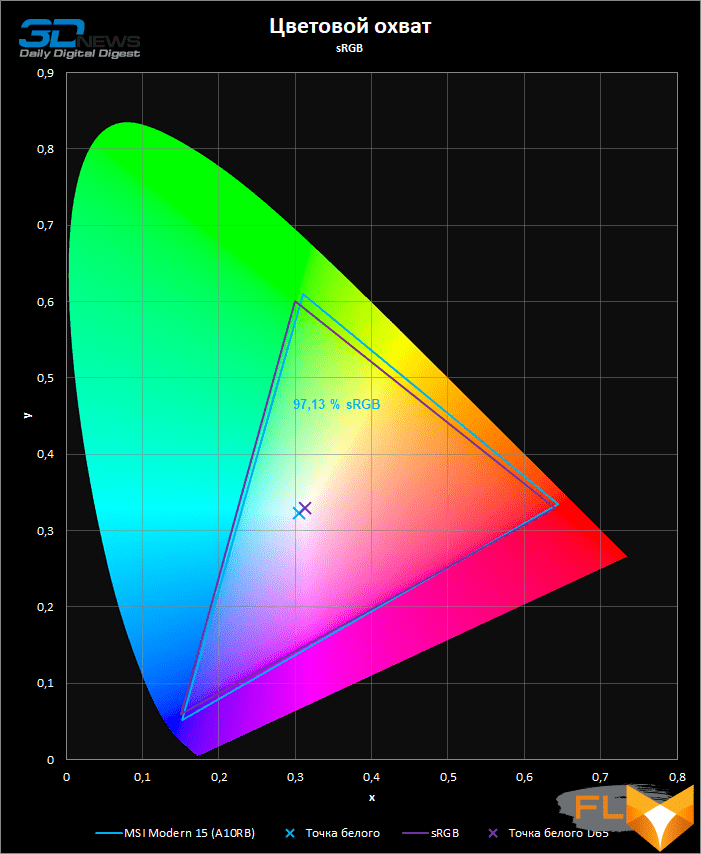
Otherwise, the picture on the Modern 15 screen will not require significant improvement, and this is always good news for users of Windows, an operating system that lacks global color correction tools. The color range of the matrix almost completely covers the sRGB space, and well-matched gamma curves give a satisfactory assessment of color accuracy (average deviation of 1.39 according to the Delta E 2000 standard). The original gray curve is overdrawn from the 2.2 reference exponential function in the 2.3 direction, but for watching videos and photos in low light conditions, this is more of an advantage than a disadvantage. Especially considering that the difference in luminosity between the black and white field here is far from a record among IPS panels.
 |
 |
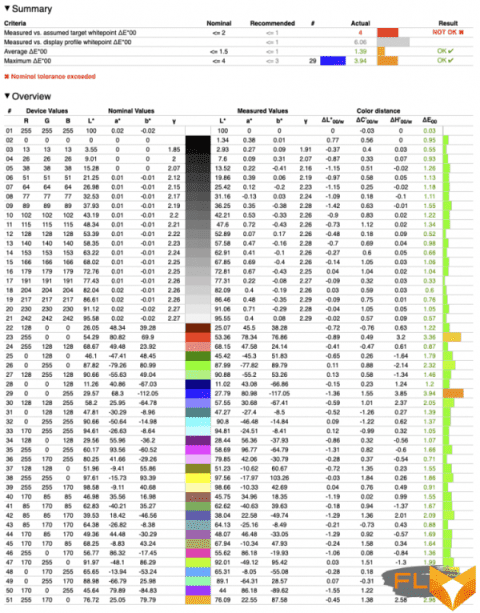
As you would expect from any modern laptop, the Modern 15’s screen is free from gross image defects, such as abundant edge flare or noticeable flicker at low brightness settings with the naked eye.
⇡#Clock speeds, temperature and noise levels
MSI’s sister model, the Prestige 14, which was also recently tested, we praised for its excellent cooling system, which easily removes heat from the six-core CPU and GeForce GTX 1650 Max-Q discrete graphics. The Modern 15 behaves similarly in various power consumption modes, which the Creator Center program allows you to change, but thanks to the fact that the 15-inch chassis has enough space for two fans at once – one for the CPU and one for the GPU – the cooler works even better. In addition, the Modern 15 has a less demanding graphics core: the nominal TDP value of the GeForce MX250 is 25 W versus 35 for the GTX 1650 Max-Q. As a result, even though the CPU here is quad-core, it can reach such power consumption and clock speeds that compact ultrabooks like the Prestige 14 could not dream of.
So, in the High Performance mode, the chip’s power consumption stabilized at 35 W, and the frequency stuck to around 3.5 GHz. Two economical profiles – Balanced and Silent in this case provide the CPU with the same operating frequencies (about 2.4 GHz) and a power reserve of 15-17 W, and all the differences between them, oddly enough, come down to the brightness of the screen matrix.
As for the discrete video adapter, the GeForce MX250, unlike more serious NVIDIA solutions, does not allow you to regulate or even measure its power consumption by software. Regardless of the power consumption mode and type of load (only on the GPU or simultaneously on the central and graphics processor), the chip threshes at the same, and at the same time quite high, frequencies in the range of 1683-1696 MHz.
| Load Clock | ||||||||
|---|---|---|---|---|---|---|---|---|
| Cinebench R20 (Max Thread #) | LuxMark 3.1 | Cinebench R20 (Max Thread #) + LuxMark 3.1 | ||||||
| CPU clock speed, MHz | GPU clock speed, MHz | CPU clock speed, MHz | GPU clock speed, MHz | |||||
| Medium | Max | Medium | Max | Medium | Max | Medium | Max | |
| MSI Modern 15 (A10RB) – Super Battery | 729 | 898 | 1696 | 1696 | 399 | 399 | 1683 | 1683 |
| MSI Modern 15 (A10RB) – Silent/Balanced | 2393 | 2594 | 1687 | 1696 | 2244 | 2296 | 1683 | 1683 |
| MSI Modern 15 (A10RB) – High Performance | 3455 | 3494 | 1696 | 1696 | 3344 | 3492 | 1683 | 1683 |
| CPU and GPU Power Reserve | ||||||||
|---|---|---|---|---|---|---|---|---|
| Cinebench R20 (Max Thread #) | LuxMark 3.1 | Cinebench R20 (Max Thread #) + LuxMark 3.1 | ||||||
| CPU power consumption, W | GPU power consumption, W | CPU power consumption, W | GPU power consumption, W | |||||
| Medium | Max | Medium | Max | Medium | Max | Medium | Max | |
| MSI Modern 15 (A10RB) – Super Battery | 4 | 4 | N/A | N/A | 4 | 5 | N/A | N/A |
| MSI Modern 15 (A10RB) – Silent/Balanced | 15 | 17 | N/A | N/A | 15 | 15 | N/A | N/A |
| MSI Modern 15 (A10RB) – High Performance | 35 | 36 | N/A | N/A | 34 | 35 | N/A | N/A |
Note The measurement is performed after the device has warmed up and all parameters have stabilized.
On top of impressive clock speeds, the MSI Modern 15 delivers benchmark temperatures. The only way to warm up the CPU to 96 ° C is to completely load both chips (CPU and GPU) with a task such as ray tracing in High Performance mode. In any other situation, the temperature of the main components does not exceed 75 ° C, and the High Performance mode itself, with an isolated load on the CPU, provides even better cooling than Balanced or Silent.
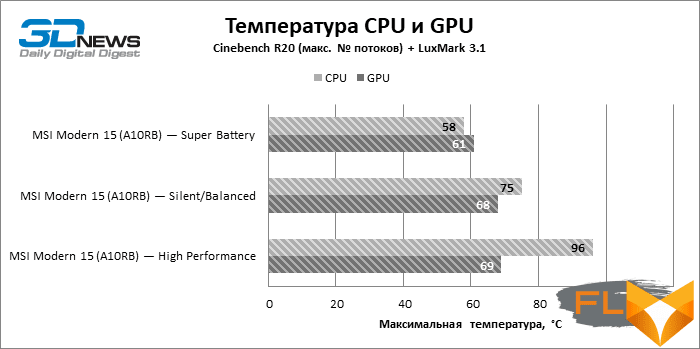
In Silent and Balanced modes, the laptop is extremely quiet, but only under an isolated load on the CPU. Well, such a power consumption of the central processor, as in the High Performance mode, quite predictably increases the noise of the cooling system up to 43 dBA without involving discrete graphics. The graph is crowned with a serious result of 49 dBA, obtained by simultaneously loading both main chips. Fortunately, such usage scenarios are still rare for the class of machines to which the new MSI belongs. But it has one strange feature: even outside of resource-intensive applications, when the computer is idle, there is a slight but noticeable noise background, almost the same as in Silent / Balanced mode under CPU load. The only way to make a computer completely silent is to switch to Super Battery mode, in which it cools passively, provided that there is no load on the discrete GPU.

⇡#Synthetic benchmarks
We ran the MSI Modern 15 in High Performance mode to pass the performance tests and were not disappointed with the results. Synthetic benchmarks already show that, although high clock frequencies do not outweigh the difference in the number of cores between certain models of Intel CPUs, they are able to largely compensate for it. Indeed, the distance between the quad-core Core i7-10510U in the MSI Modern 15 and the hexa-core Core i7-10710U in the Prestige 14 is far from the theoretical 50% performance. A real breakthrough in performance can only be provided by eight cores, which are available in the ninth-generation Core i9 mobile processors with the H index, but in this case we are talking about an incomparably higher level of power consumption and, no less important, devices of a different price category.

The discrete video core of the GeForce MX250 on the GP108 chip is no match for the more modern solutions from the NVIDIA GTX 16 family (and even more so the GeForce RTX) or the similarly fast mobile Radeon 5000 series. However, the MX250 is not designed for advanced games, but for undemanding entertainment it will be quite enough, and, most importantly, against the background of any kind of integrated Intel graphics, even a low-power discrete GPU can speed up operations in work applications such as photo processing programs. We will deal with them now.
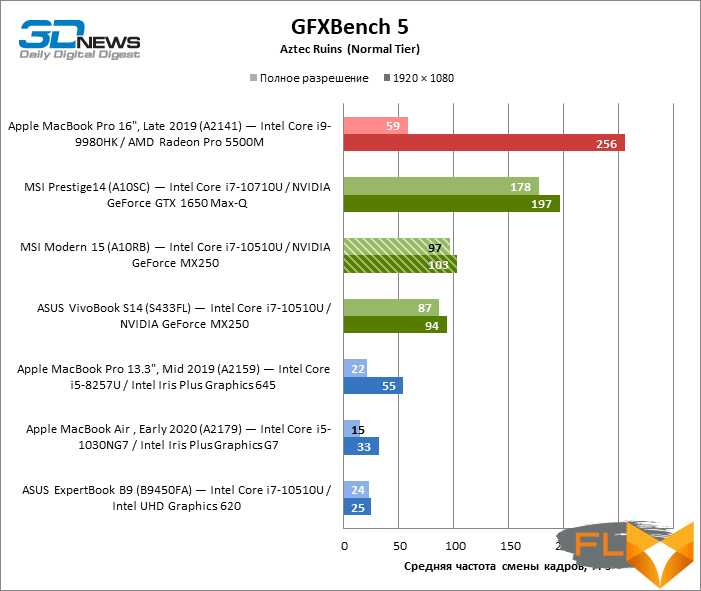
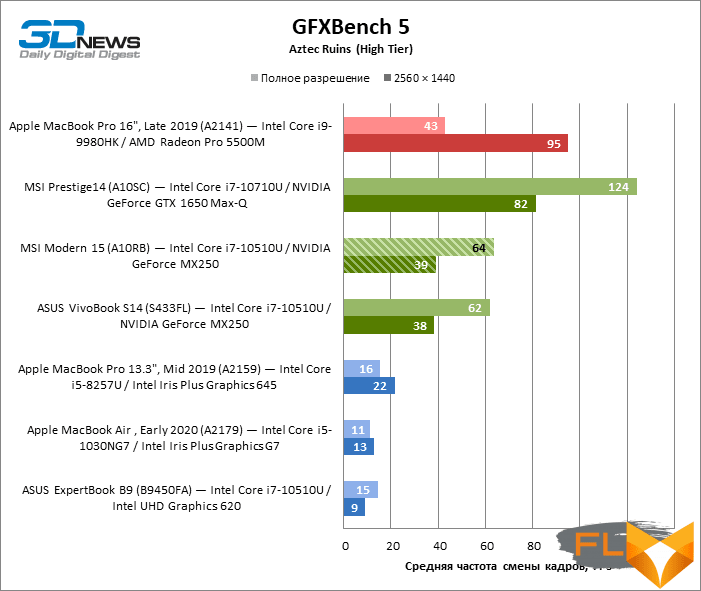
⇡#Performance in production applications
Rendering in Blender using the Cycles engine, which we use as a universal CPU and GPU benchmark, completed almost equally quickly on the six-core Core i7-10710U and on the quad-core Core i7-10510U, which is equipped with the MSI Modern 15. It’s all, of course, in increased clock frequencies. For the same reason, Modern 15 is more than 1.5 times faster than a device with almost identical hardware configuration (ASUS VivoBook S14), not to mention ultra-thin 13- and 14-inch laptops.
The results of Blender’s GPU benchmarks (in Cycles and Radeon ProRender renderers) were also affected by Modern 15’s powerful cooling system, although not as much. Moreover, there can be no question that the GeForce MX250 will compete with mid-range graphics adapters that are installed in expensive laptops with a screen diagonal of 15.6 inches.
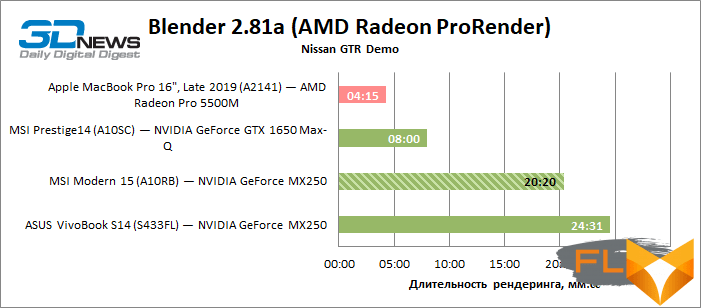
MSI Modern 15 does not pretend to be a mobile workstation, but if we exclude excessively complex tasks (like the same ray tracing in Blender), this model proved to be excellent in less demanding professional applications. So, Adobe Lightroom uses the GPU only for selected tasks and, apparently, is not friendly with multi-threaded execution on six- and eight-core processors. As a result, the Modern 15 is by and large on par with even the latest 16-inch MacBook Pro in this test, and outperforms systems with better discrete graphics.
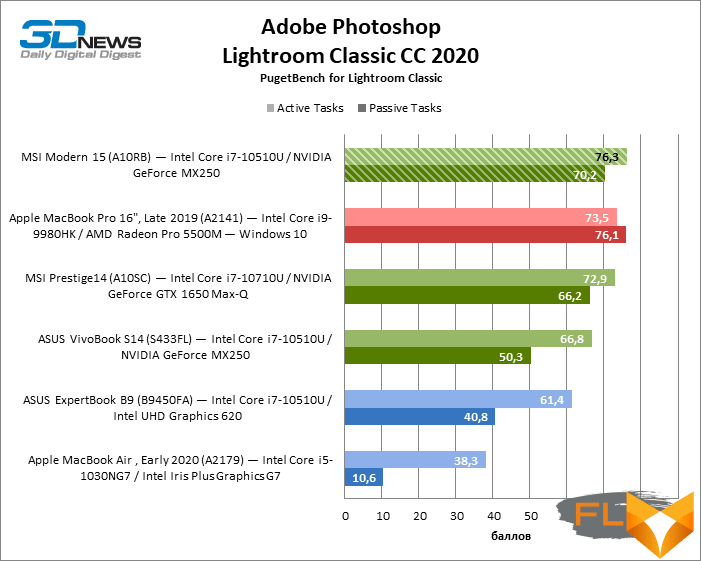
Note Scores are calculated as a percentage of Intel Reference Workstation performance Core i9-9900K, NVIDIA GeForce RTX 2080, 64GB RAM.
A similar picture emerged in the Photoshop benchmark. The octa-core CPU is useful for operations such as filtering, and the powerful discrete GPU is useful for those functions of the photo editor that use the graphics core most actively. But if you choose between four cores running at a high clock speed and six slower ones, then Photoshop prefers the MSI Modern 15.
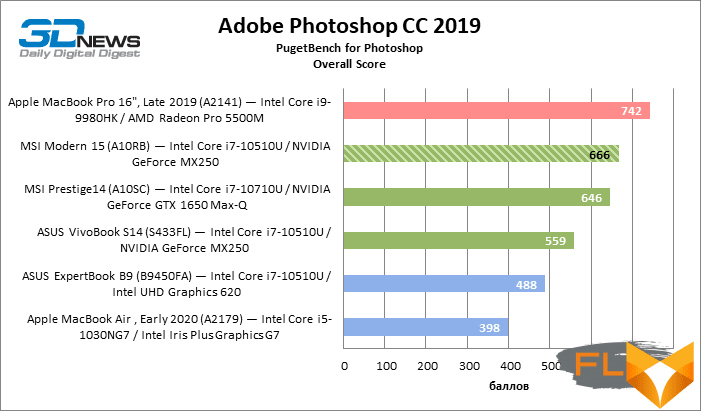
Note Scores are calculated as a percentage of Intel Reference Workstation performance Core i9-9900K, NVIDIA GeForce RTX 2080 and 64GB RAM x 10.

Note Scores are calculated as a percentage of Intel Reference Workstation performance Core i9-9900K, NVIDIA GeForce RTX 2080, 64GB RAM.
Editing 4K video in Adobe Premiere Pro is a dubious pleasure on laptops without powerful discrete graphics. But MSI Modern 15 performed quite convincingly here too. When editing and exporting videos flavored with GPU effects, high-quality cooling and high clock frequencies do not compensate for the lack of performance of the GeForce MX250 chip. But in other cases, when the load falls mainly on the CPU, Modern 15 can achieve an acceptable frame rate, provided that the user reduces the resolution of the viewport to ¼ of the original (which is exactly what a 1080p screen is). A quad-core CPU is not a problem, here again it coped with the task no worse than six-core chips, more limited by the power reserve.
 |
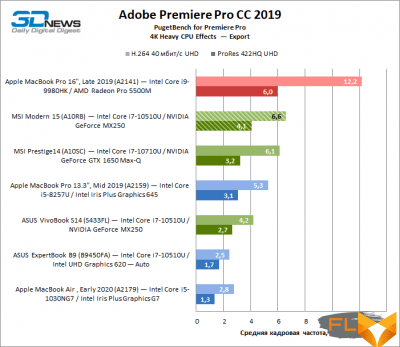 |
|
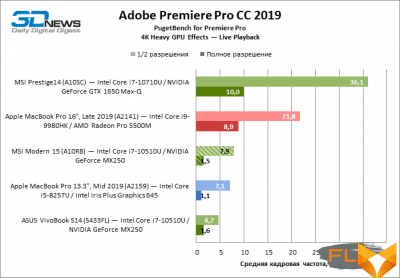 |
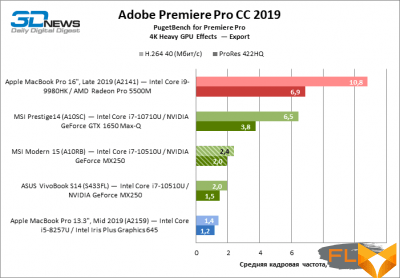 |
⇡#SSD Performance
Inside the MSI Modern 15, for once, we found a solid state drive that does not belong to the extremely popular Samsung PM981 series among OEM customers. This is an SSD called PC SN730 manufactured by Western Digital, which, according to its passport data, is very reminiscent of the WD Black SN750. As tests have shown, the SN730 indeed behaves in various load patterns in a similar way, including mediocre linear read and write speeds. In addition, today’s 512 GB drives are simply not able to achieve the same throughput as higher-capacity devices. However, given the short command queue and the predominant data read requests that are typical for most desktop applications, the Modern 15 owner can hardly find a reason to complain about the performance of the SSD and the overall system responsiveness.
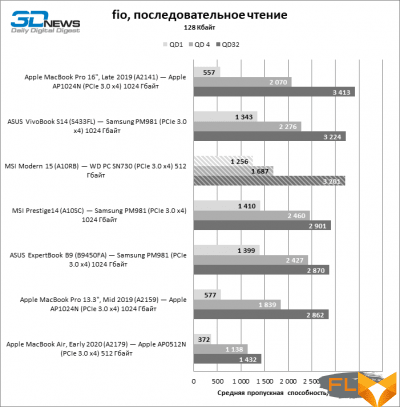 |
 |
|
 |
 |
⇡#Battery life
Despite the fact that the battery capacity of the MSI Modern 15 is far from being a record for laptops with a screen diagonal of 15.6 inches (only 52 Wh), the computer knows how to effectively dispose of it. As we found out earlier, the Super Battery mode lowers the operating frequencies of the CPU under load below 1 GHz, but when the time away from the outlet is more important than performance, the user can count on at least 6.5 hours (of course, with a reduced matrix brightness) of video viewing or web surfing.
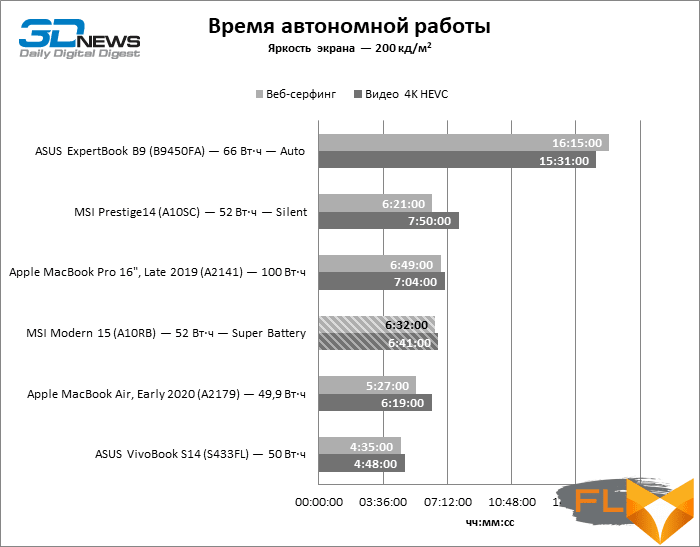
⇡#Conclusions
The MSI Modern 15 has a lot in common with another MSI model, the Prestige 14, which also recently visited us. Even if these two laptops are aimed at completely different consumer groups. The MSI Prestige 14 (as well as its larger sister model, the Prestige 15) lays claim to the laurels of compact workstations and has a proper hardware configuration: six-core CPUs combined with relatively powerful GeForce GTX 1650 Max-Q discrete graphics. The MSI Modern 15, on the other hand, is an inexpensive machine for office work and low-performance home activities. Nevertheless, after we have completed testing both models, the conclusion suggests itself that the priorities of their constructors were the same. As a result, the list of advantages and disadvantages for the ambitious Prestige 14 and the practical Modern 15, when compared with similar models in both price categories, is common.
The main advantage of Modern 15 is the outstanding level of performance that MSI managed to squeeze out of an economical quad-core CPU thanks to a powerful cooling system: in a number of benchmarks, it outperformed even Intel’s six-core U-series models. As for the GPU, even though the GeForce MX250 is a weak and not the most recent solution, it backs up the CPU well in tasks such as photo processing and video encoding. Moreover, in the price niche of Modern 15, the presence of discrete graphics as such is not at all guaranteed. Add to this the extensive upgrade options (both RAM and SSD – all this can be easily changed) – and you get a tempting offer for those who are most interested in high CPU performance with a small weight and dimensions of a laptop.
The only pity is that the results of our tests, strictly speaking, refer only to the older version of the Modern 15 with a Core i7-10510U processor, which, at a minimum retail price, comes close to the lower configurations of the MSI Prestige 15 equipped with GeForce GTX 1650 Max-Q graphics, but more weak CPU brand Core i5-10210U. At this point, the buyer is faced with a choice: either a high-speed central processing unit or a gaming video adapter.
Finally, Modern 15 is not as good in everything as it is in hardware performance. The MSI laptop caused us the same complaints about the mechanics that we presented earlier with the Prestige 14. No doubt, this is one of the lightest models with a 15-inch screen and a discrete GPU, but, as a result, the rigidity of the case (especially under the keyboard) leaves much to be desired the best. And the keyboard itself is unlikely to suit masters of high-speed blind typing. Finally, the screen could be brighter, and the battery bigger, but this, whatever one may say, is the cost of the model’s price orientation.


